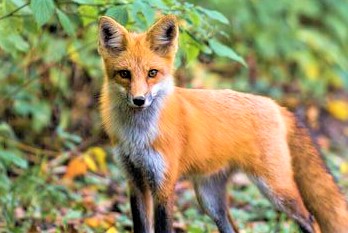the fox

the fox

Fox is the name given to various omnivorous mammals of the Canidae family. Species belonging to the genus Vulpes are considered true foxes , such as the red fox ( Vulpes vulpes ) and the arctic fox ( Vulpes lagopus ).
Foxes have a dog-like appearance, characterized by their pointed, erect nose, pointed ears and a bushy tail, which is associated with balance as well as the warmth of the animal. Mice, hares, fish, carrion, and fruits are some of the products that can be part of the diet of these animals.
Summary of foxes
- They are mammals of the Canidae family.
- The healthy ones are those who belong to the genus foxes.
- They have a pointed nose, flattened skull, erect, pointed ears and a bushy tail.
- Despite what many people think, they are omnivores, meaning they feed on both animal and plant products.
- Some are monogamous.

Fox
Fox is a common name used to refer to various species of the Canidae family, such as wolves, coyotes, and dogs. They are generally called true foxes , and belong to the genus Vulpes, such as the red fox ( Vulpes vulvae ) and the arctic fox ( Vulpes vulgaris ).
fox characteristics
Foxes are animals that have similar characteristics to dogs . It is an animal with a pointed snout, flattened skull, erect and pointed ears, and a bushy tail. Its tail is associated with balance and also with heating the body of mammals, being an excellent weapon against the cold.
Foxes can vary in size, but generally range from 92 cm to 107 cm and weigh 5 kg. Another characteristic that varies by species is the color of the coat, which in some foxes changes throughout the year. Coat density is also an important feature, being denser in animals that live in colder places and thinner in animals that live in warmer environments.
fox behavior
Most foxes are solitary . They usually stay within a particular area, being territorial. They are able to communicate with each other through vocalizations and also through scents produced by different scent glands located in different parts of their bodies, such as the nose and tail. Vocalizations include, for example, vocalizations to identify individuals and alert other foxes to danger; It is also observed during the mating season.
fox food
Foxes are omnivores, that is, they feed on both animal and plant products. They can eat, for example, rodents, rabbits, fish, birds, eggs, seeds, fruits, and carrion. Some also feed on feces.
Fox breeding
Depending on the species studied, we can note some unique characteristics regarding reproduction. Some foxes, for example, are a monogamous , with the pairs staying together for life. In other cases, males have multiple reproductive partners .
In general, a fox’s pregnancy lasts seven to eight weeks . With each pregnancy, females give birth to, on average, one to 11 young, which are born blind and remain inside underground burrows.
In these burrows, females nurse and care for their young. Males play an important role in capturing food and carrying it to burrows. The cubs, after weaning, learn hunting techniques from their parents, accompanying them on hunts. When they are ready, they start their lives independently.
red fox
The red fox ( Vulpes vulpes ) is a species that occurs in different parts of the northern hemisphere and can be observed in different habitats, for example, in tundra, grasslands, mountains, deserts, and urban areas. It stands out as the largest among the true foxes , with its body length, including the head, ranging from 45.5 cm to 90 cm and the tail from 30 cm to 55.5 cm. It can weigh from 3 to 14 kg.
Red foxes have fur on the upper body that varies in color from red to brown. On the underparts, the hairs are lighter. In the lower area of their legs, the color is usually black. At the tip of the tail, the hairs can be black or white.
Their pregnancy lasts between 51 and 53 days , and litters can consist of one to 13 pups. At birth, red fox pups weigh between 50g and 150g. In this species, weaning occurs around eight to 10 weeks of life.
Arctic fox

Arctic foxes ( Vulpes lagopus ) are seen in arctic regions, and they occur in arctic and alpine tundra. It is smaller in size with a body length of 46 cm to 68 cm and a tail of about 35 cm. It can weigh between 2.9 kg and 7.7 kg.
This type of fox lives in areas with severe and snowy winters. During this time of year, arctic foxes have a white coat that ensures they are camouflaged in the snow. In summer, however, this white coat is replaced by brown, an important change to allow camouflage to occur also in the snowless environment.
Arctic foxes live in burrows and can dig tunnels in the snow during times of snowfall, thus creating shelters for these times. It is noted in the burrows that a family group is made up of the adult male, the litter, and two foxes , one of whom is a non-breeding animal born in the previous year and who helps take care of the litter. .
Arctic foxes are monogamous , and their gestation period ranges from 49 to 57 days. Generally, a litter consists of five to eight puppies. In this species, the young are weaned when they are two to four weeks old. Reaching sexual maturity in less than 10 months.



